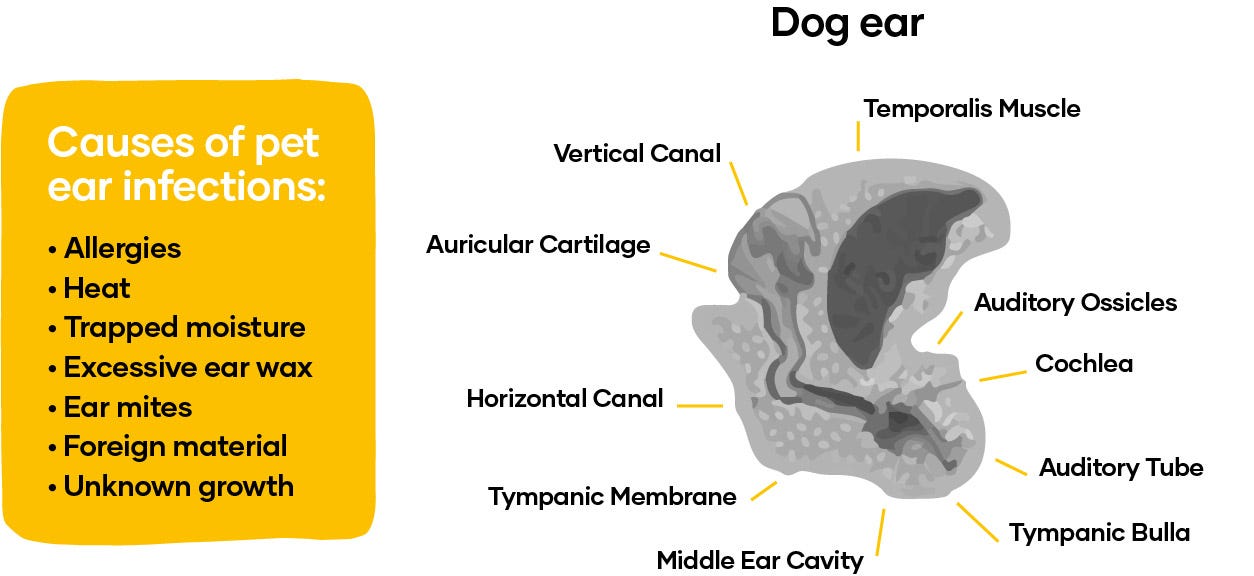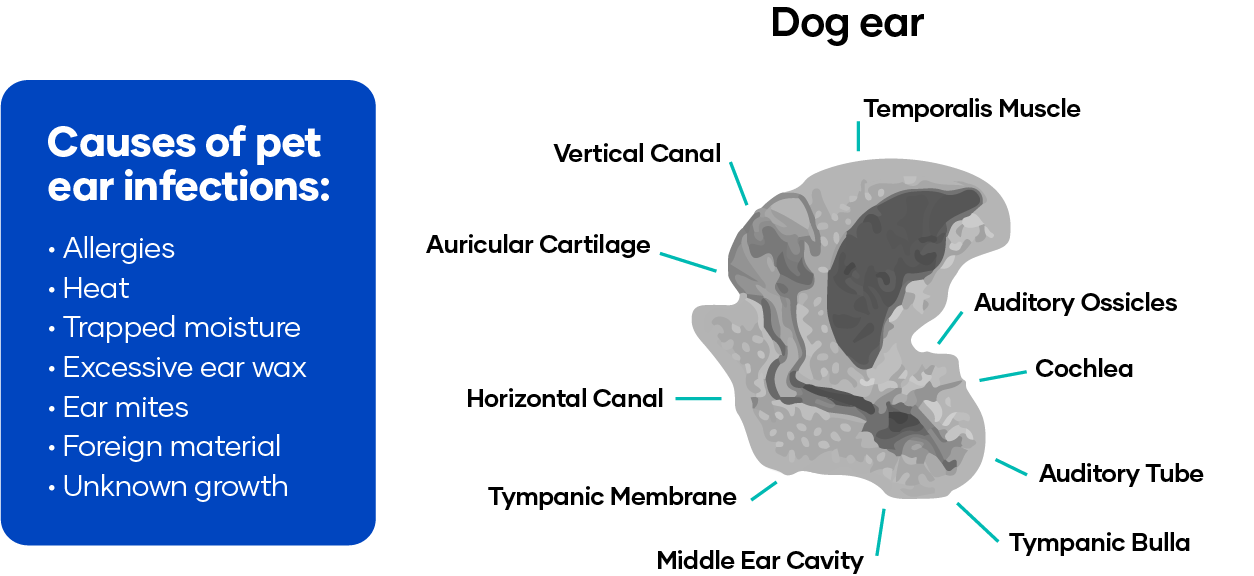Pet ear infections
If you’ve ever had an earache, you know how painful and distressing it can be. Our pets may suffer from this problem often, especially in the warmer months - as the environmental allergens and warmer temperatures can cause flare up's.
Read on to learn about pet ear infections and how to identify if your pet has sore or infected ears.
Ear infections, also referred to as Otitis Externa, are a common problem seen amongst our furry friends, (especially those with long ears). Ear infections can cause extreme discomfort and further health problems if left untreated. There are many types of infectious bacteria, fungi, parasites, and foreign material which might cause inflammation and infection in the outer, middle, or inner ears.
Causes of pet ear infections
Dogs’ and cats’ ear canals are shaped like a long, ‘L’. They are great for hearing, but this shape predisposes them to collect debris and moisture. The most common causes of ear infections include allergies, heat, trapped moisture, and excessive earwax. Infection can also be caused by ear mites, foreign material like a grass seed, or an unknown growth.
Some breeds, particularly those with large floppy or hairy ears such as Cocker Spaniels, Poodles or Golden Retrievers, can be more prone to ear infections. However, they can occur in any breed.

Symptoms of an ear infection:
Healthy ears are generally pink, clean, and have an unobtrusive smell. A pet suffering from an ear infection could show a number of symptoms including:
- Ears appear red/inflamed, and a black/brown or yellowish discharge may be seen
- Strong odour
- Constant ear scratching or shaking of the head
- Swelling around the ear
- Whimpering due to discomfort
Or more seriously:
- Loss of balance
- Hearing loss
- Unusual eye movements
- Walking in circles or head tilting
Note: These symptoms could also indicate another health problem. If you notice one of these symptoms, consult your vet for a proper diagnosis immediately.
Ears are very sensitive. If you feel your pet may have a problem, please contact your local Animates Vetcare clinic. Having your pet’s ear examined by a veterinarian will allow them to determine whether the eardrum is intact or if there are any foreign materials in the ear canal. Vets can also attain a swab sample for further diagnostics. Your vet will diagnose the cause of the problem and provide the best treatment and home care plan to combat the condition and have your pet in top shape once again.
How are pet ear infections diagnosed?
A thorough clinical examination, including examining your pet’s skin, will allow your veterinarian to determine the cause of the infection and whether the eardrum is intact and if there are any foreign materials in the canal. When a pet is in extreme pain and refuses to allow the examination, it may be necessary to sedate or anesthetise the pet for a more thorough examination and diagnosis.
How are ear infections treated?
In many cases, ear drops can be applied to the affected ear. If there is foreign matter or excess discharge in the ear canal, the pet may need to be sedated or anaesthetised so that it can be removed prior to the ear drops being administered. Sometimes, more than one type of infection could be diagnosed, and this may require the use of multiple medications. Your veterinarian will recommend a tailored treatment plan based on the diagnosis.
Aftercare at home:
- Follow the medication directions that have been advised by your veterinarian
- Only used medications prescribed by your veterinarian
- Avoid the ears getting wet – no swimming and only wash the head with a damp cloth
Preventing a reoccurrence:
- Please follow all veterinary home care instructions to the end of its course
- Check your pet’s ears regularly
- If you notice any recurring symptoms, please make an appointment with your vet
Ear infections, also referred to as Otitis Externa, are a common problem seen amongst our furry friends, (especially those with long ears). Ear infections can cause extreme discomfort and further health problems if left untreated. There are many types of infectious bacteria, fungi, parasites, and foreign material which might cause inflammation and infection in the outer, middle, or inner ears.
Causes of pet ear infections
Dogs’ and cats’ ear canals are shaped like a long, ‘L’. They are great for hearing, but this shape predisposes them to collect debris and moisture. The most common causes of ear infections include allergies, heat, trapped moisture, and excessive earwax. Infection can also be caused by ear mites, foreign material like a grass seed, or an unknown growth.
Some breeds, particularly those with large floppy or hairy ears such as Cocker Spaniels, Poodles or Golden Retrievers, can be more prone to ear infections. However, they can occur in any breed.

Symptoms of an ear infection:
Healthy ears are generally pink, clean, and have an unobtrusive smell. A pet suffering from an ear infection could show a number of symptoms including:
Ears appear red/inflamed, and a black/brown or yellowish discharge may be seen
- Strong odour
- Constant ear scratching or shaking of the head
- Swelling around the ear
- Whimpering due to discomfort
Or more seriously:
- Loss of balance
- Hearing loss
- Unusual eye movements
- Walking in circles or head tilting
Note: These symptoms could also indicate another health problem. If you notice one of these symptoms, consult your vet for a proper diagnosis immediately.
Ears are very sensitive. If you feel your pet may have a problem, please contact your local Animates Vetcare clinic. Having your pet’s ear examined by a veterinarian will allow them to determine whether the eardrum is intact or if there are any foreign materials in the ear canal. Vets can also attain a swab sample for further diagnostics. Your vet will diagnose the cause of the problem and provide the best treatment and home care plan to combat the condition and have your pet in top shape once again.
How are pet ear infections diagnosed?
A thorough clinical examination, including examining your pet’s skin, will allow your veterinarian to determine the cause of the infection and whether the eardrum is intact and if there are any foreign materials in the canal. When a pet is in extreme pain and refuses to allow the examination, it may be necessary to sedate or anesthetise the pet for a more thorough examination and diagnosis.
How are ear infections treated?
In many cases, ear drops can be applied to the affected ear. If there is foreign matter or excess discharge in the ear canal, the pet may need to be sedated or anaesthetised so that it can be removed prior to the ear drops being administered. Sometimes, more than one type of infection could be diagnosed, and this may require the use of multiple medications. Your veterinarian will recommend a tailored treatment plan based on the diagnosis.
Aftercare at home:
- Follow the medication directions that have been advised by your veterinarian
- Only used medications prescribed by your veterinarian
- Avoid the ears getting wet – no swimming and only wash the head with a damp cloth
Preventing a reoccurrence:
- Please follow all veterinary home care instructions to the end of its course
- Check your pet’s ears regularly
- If you notice any recurring symptoms, please make an appointment with your vet








